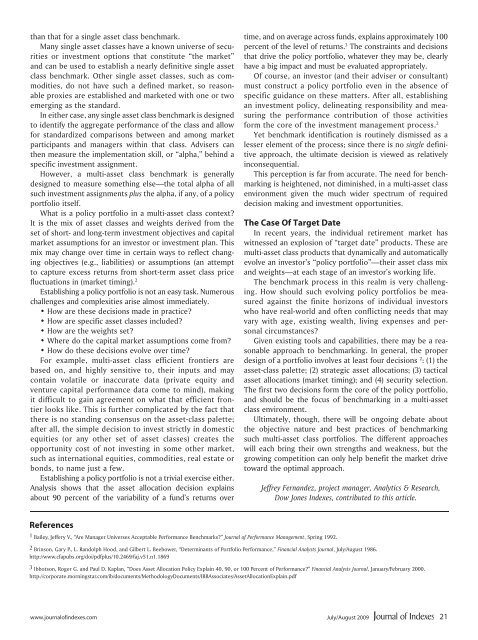How to Kill a Black Swan Remy Briand and David Owyong ...
How to Kill a Black Swan Remy Briand and David Owyong ...
How to Kill a Black Swan Remy Briand and David Owyong ...
You also want an ePaper? Increase the reach of your titles
YUMPU automatically turns print PDFs into web optimized ePapers that Google loves.
than that for a single asset class benchmark.<br />
Many single asset classes have a known universe of securities<br />
or investment options that constitute “the market”<br />
<strong>and</strong> can be used <strong>to</strong> establish a nearly definitive single asset<br />
class benchmark. Other single asset classes, such as commodities,<br />
do not have such a defined market, so reasonable<br />
proxies are established <strong>and</strong> marketed with one or two<br />
emerging as the st<strong>and</strong>ard.<br />
In either case, any single asset class benchmark is designed<br />
<strong>to</strong> identify the aggregate performance of the class <strong>and</strong> allow<br />
for st<strong>and</strong>ardized comparisons between <strong>and</strong> among market<br />
participants <strong>and</strong> managers within that class. Advisers can<br />
then measure the implementation skill, or “alpha,” behind a<br />
specific investment assignment.<br />
<strong>How</strong>ever, a multi-asset class benchmark is generally<br />
designed <strong>to</strong> measure something else—the <strong>to</strong>tal alpha of all<br />
such investment assignments plus the alpha, if any, of a policy<br />
portfolio itself.<br />
What is a policy portfolio in a multi-asset class context?<br />
It is the mix of asset classes <strong>and</strong> weights derived from the<br />
set of short- <strong>and</strong> long-term investment objectives <strong>and</strong> capital<br />
market assumptions for an inves<strong>to</strong>r or investment plan. This<br />
mix may change over time in certain ways <strong>to</strong> reflect changing<br />
objectives (e.g., liabilities) or assumptions (an attempt<br />
<strong>to</strong> capture excess returns from short-term asset class price<br />
fluctuations in (market timing). 2<br />
Establishing a policy portfolio is not an easy task. Numerous<br />
challenges <strong>and</strong> complexities arise almost immediately.<br />
• <strong>How</strong> are these decisions made in practice?<br />
• <strong>How</strong> are specific asset classes included?<br />
• <strong>How</strong> are the weights set?<br />
• Where do the capital market assumptions come from?<br />
• <strong>How</strong> do these decisions evolve over time?<br />
For example, multi-asset class efficient frontiers are<br />
based on, <strong>and</strong> highly sensitive <strong>to</strong>, their inputs <strong>and</strong> may<br />
contain volatile or inaccurate data (private equity <strong>and</strong><br />
venture capital performance data come <strong>to</strong> mind), making<br />
it difficult <strong>to</strong> gain agreement on what that efficient frontier<br />
looks like. This is further complicated by the fact that<br />
there is no st<strong>and</strong>ing consensus on the asset-class palette;<br />
after all, the simple decision <strong>to</strong> invest strictly in domestic<br />
equities (or any other set of asset classes) creates the<br />
opportunity cost of not investing in some other market,<br />
such as international equities, commodities, real estate or<br />
bonds, <strong>to</strong> name just a few.<br />
Establishing a policy portfolio is not a trivial exercise either.<br />
Analysis shows that the asset allocation decision explains<br />
about 90 percent of the variability of a fund’s returns over<br />
time, <strong>and</strong> on average across funds, explains approximately 100<br />
percent of the level of returns. 3 The constraints <strong>and</strong> decisions<br />
that drive the policy portfolio, whatever they may be, clearly<br />
have a big impact <strong>and</strong> must be evaluated appropriately.<br />
Of course, an inves<strong>to</strong>r (<strong>and</strong> their adviser or consultant)<br />
must construct a policy portfolio even in the absence of<br />
specific guidance on these matters. After all, establishing<br />
an investment policy, delineating responsibility <strong>and</strong> measuring<br />
the performance contribution of those activities<br />
form the core of the investment management process. 2<br />
Yet benchmark identification is routinely dismissed as a<br />
lesser element of the process; since there is no single definitive<br />
approach, the ultimate decision is viewed as relatively<br />
inconsequential.<br />
This perception is far from accurate. The need for benchmarking<br />
is heightened, not diminished, in a multi-asset class<br />
environment given the much wider spectrum of required<br />
decision making <strong>and</strong> investment opportunities.<br />
The Case Of Target Date<br />
In recent years, the individual retirement market has<br />
witnessed an explosion of “target date” products. These are<br />
multi-asset class products that dynamically <strong>and</strong> au<strong>to</strong>matically<br />
evolve an inves<strong>to</strong>r’s “policy portfolio”—their asset class mix<br />
<strong>and</strong> weights—at each stage of an inves<strong>to</strong>r’s working life.<br />
The benchmark process in this realm is very challenging.<br />
<strong>How</strong> should such evolving policy portfolios be measured<br />
against the finite horizons of individual inves<strong>to</strong>rs<br />
who have real-world <strong>and</strong> often conflicting needs that may<br />
vary with age, existing wealth, living expenses <strong>and</strong> personal<br />
circumstances?<br />
Given existing <strong>to</strong>ols <strong>and</strong> capabilities, there may be a reasonable<br />
approach <strong>to</strong> benchmarking. In general, the proper<br />
design of a portfolio involves at least four decisions 2 : (1) the<br />
asset-class palette; (2) strategic asset allocations; (3) tactical<br />
asset allocations (market timing); <strong>and</strong> (4) security selection.<br />
The first two decisions form the core of the policy portfolio,<br />
<strong>and</strong> should be the focus of benchmarking in a multi-asset<br />
class environment.<br />
Ultimately, though, there will be ongoing debate about<br />
the objective nature <strong>and</strong> best practices of benchmarking<br />
such multi-asset class portfolios. The different approaches<br />
will each bring their own strengths <strong>and</strong> weakness, but the<br />
growing competition can only help benefit the market drive<br />
<strong>to</strong>ward the optimal approach.<br />
Jeffrey Fern<strong>and</strong>ez, project manager, Analytics & Research,<br />
Dow Jones Indexes, contributed <strong>to</strong> this article.<br />
References<br />
1 Bailey, Jeffery V., “Are Manager Universes Acceptable Performance Benchmarks?” Journal of Performance Management, Spring 1992.<br />
2 Brinson, Gary P., L. R<strong>and</strong>olph Hood, <strong>and</strong> Gilbert L. Beebower, “Determinants of Portfolio Performance,” Financial Analysts Journal, July/August 1986.<br />
http://www.cfapubs.org/doi/pdfplus/10.2469/faj.v51.n1.1869<br />
3 Ibbotson, Roger G. <strong>and</strong> Paul D. Kaplan, “Does Asset Allocation Policy Explain 40, 90, or 100 Percent of Performance?” Financial Analysts Journal, January/February 2000.<br />
http://corporate.morningstar.com/ib/documents/MethodologyDocuments/IBBAssociates/AssetAllocationExplain.pdf<br />
www.journalofindexes.com July/August 2009<br />
21
















